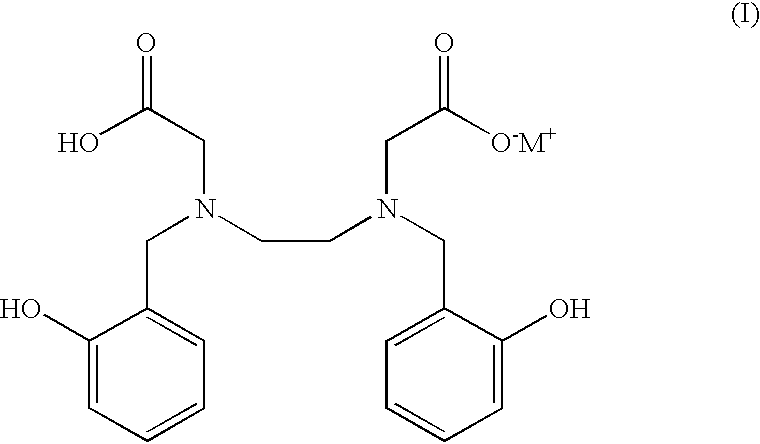N,N'-bis(2-hydroxybenzyl)ethylenediamine-N,N'-diacetic acid in iron chelating therapy
a technology of diacetic acid and ethylenediamine, which is applied in the field of primates' improvement of treatment methods, can solve the problems of specific mechanism that exists for the elimination of excess iron, iron toxicity, peroxidative tissue damage, etc., and achieve the effect of minimizing allergic reactions
- Summary
- Abstract
- Description
- Claims
- Application Information
AI Technical Summary
Benefits of technology
Problems solved by technology
Method used
Image
Examples
example 1
This example explains how to handle Cebus apella monkeys for testing to determine the effectiveness of the method and composition of this invention.
A. Iron Loading of Cebus apella Monkeys
After intramuscular anesthesia with ketamine, an intravenous infusion was started in a leg vein. Iron dextran was added to approximately 90 mL of sterile normal saline and administered to the animals by slow infusion at a dose of 200 to 300 mg iron per Kg body weight over 45 to 60 minutes. Two to three infusions, separated by between 10 and 14 days, were necessary to provide about 500 mg iron per Kg body weight. After administration of iron dextran, the serum transferrin iron saturation rose to 70-80%. The serum half-life of iron dextran in humans is 2.5 to 3.0 days. At least twenty half-lives, sixty days, passed before using any of the animals in experiments evaluating iron-chelating agents.
B. Iron-balance Studies in Cebus apella Monkeys
Seven days before the administration of the drug, the animals ...
example 2
This example explains how to prepare a formulation for s.c. administration and to compare to a method for oral administration.
Drug Preparation and Administration
In the primates, DFOM was administered s.c. in sterile water for injection at a dose of 150 .mu.moles / Kg, while HBED was first dissolved in a phosphate buffer, ph 7.4, thus forming the mono-sodium salt and given s.c. in 40% wt. / vol. Cremophor RH40 at a dose of 75 or 150 .mu.moles / Kg. In addition, in order to more closely mimic clinical applications in patients, mono-sodium HBED was also given to the monkeys s.c. at a dose of 150 .mu.moles / Kg in a phosphate buffer; no Cremophor vehicle was used.
Calculation of Iron Chelator Efficiency
The efficiency of each chelator was calculated on the basis of a 1:1 ligand-iron complex. In the monkeys, the numbers were generated by averaging the iron output for four days prior to the administration of the drug, subtracting these numbers from the two-day iron clearance after the administratio...
example 3
This example compares the effectiveness in Cebus apella monkeys of subcutaneously administered mono-sodium salt of HBED (MS HBED) in accordance with the invention vs. orally administered HBED monohydrochloride monohydrate and subcutaneously administered DFOM. The comparators include the timeline of iron excretion induced by the iron chelators and the peak amounts of iron excreted.
Chelator-induced Iron Excretion in Cebus apella Monkeys
The studies were conducted with Cebus apella monkeys to which had been previously administered intravenous iron dextran to provide about 500 mg iron per Kg body weight, as described above. Groups of monkeys (n=6 in each group) were given s.c. injections of either DFOM or MS HBED. DFOM in aqueous solution was given s.c. at a dose of 150 .mu.moles / Kg and induced the excretion of 435.+-.115 .mu.g Fe / Kg body weight and was found to have an. efficiency of 5.1.+-.1.3% (range, 3.3 to 6.6%), with about 65% of the chelator-induced iron excretion in the stool and...
PUM
| Property | Measurement | Unit |
|---|---|---|
| body weight | aaaaa | aaaaa |
| body weight | aaaaa | aaaaa |
| body weight | aaaaa | aaaaa |
Abstract
Description
Claims
Application Information
 Login to View More
Login to View More - R&D
- Intellectual Property
- Life Sciences
- Materials
- Tech Scout
- Unparalleled Data Quality
- Higher Quality Content
- 60% Fewer Hallucinations
Browse by: Latest US Patents, China's latest patents, Technical Efficacy Thesaurus, Application Domain, Technology Topic, Popular Technical Reports.
© 2025 PatSnap. All rights reserved.Legal|Privacy policy|Modern Slavery Act Transparency Statement|Sitemap|About US| Contact US: help@patsnap.com


